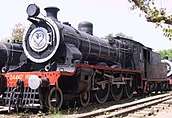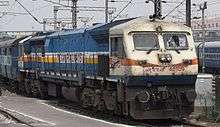Indian locomotive class WCM-3
The Indian locomotive class WCM-3 is a class of 1.5 kV DC electric locomotives that was developed in 1958 by Hitachi for Indian Railways. The model name stands for broad gauge (W), Direct Current (C), Mixed traffic (M) engine, 3rd generation (3). They entered service in 1958. A total of 3 WCM-3 locomotives was built at Japan between 1957 and 1958.
| Indian locomotive class WCM-3 | |||||||||||||||||||||||||||||||||||||||||||||||||||||||||||||
|---|---|---|---|---|---|---|---|---|---|---|---|---|---|---|---|---|---|---|---|---|---|---|---|---|---|---|---|---|---|---|---|---|---|---|---|---|---|---|---|---|---|---|---|---|---|---|---|---|---|---|---|---|---|---|---|---|---|---|---|---|---|
 A WCM-3 and a WCG-1 at Vasai Railway station. | |||||||||||||||||||||||||||||||||||||||||||||||||||||||||||||
| |||||||||||||||||||||||||||||||||||||||||||||||||||||||||||||
| |||||||||||||||||||||||||||||||||||||||||||||||||||||||||||||
| |||||||||||||||||||||||||||||||||||||||||||||||||||||||||||||
| |||||||||||||||||||||||||||||||||||||||||||||||||||||||||||||
The WCM-3 served both passenger and freight trains for over 37 years. With the introduction of more modern types of locomotives and 25 KV AC electrification, all were withdrawn in early 1990s after repeated failures. Today sadly all locomotives have been Scrapped.
History
The history of WCM-3 begins in the early 1950s with the stated aim of the Indian Railways (IR) to remove steam locomotives working in the Eastern Railways (ER) after recommendation of Karnail Singh Fuel Committee.[1][2] In 1950s the Kolkata Suburban Railway was established and electrified with overhead 3000V DC supply.[3] So Indian Railways began to look at various designs.
Initially, the Indian railways invited tenders to build locomotives to the new specification. The following responses were received:
- Hitachi submitted their model with 3600 hp with top speed of 105 km/h. They also had Co-Co bogies
- Vulcan Foundry and English Electric submitted their model with 3120 hp with top speed of 105 km/h.
Each company submitted their prototypes and Indian Railways designated these prototypes as the WCM-3 class and WCM-2 class respectively.[4]
So Indian Railways decided to procure 3 3000 V DC electric locomotives from Hitachi. They are manufactured in Japan and shipped to India in 1957. These locomotives were the third mixed class electric locomotive to roam India and also had now common Co-Co wheel arrangement.[5] Initially the WCM-3 class were known as EM/3 class. They were easily recognizable with their smaller size and separate light enclosures for the marker lights and the tail lamps (just above the buffers). They had their cab doors placed near the cab unlike the WCM-1 class.
The WCM-3 were first used on trains in the Kolkata suburban section and a black livery with a red lining in the middle.[6] But by 1960 the Kolkata Suburban Railway was converted to 25,000 V AC, so the 3 year old WCM-3 units were rendered unusable. So Research Design and Standards Organisation (RDSO) decided to converted the quite new locomotives to run on the 1500V DC Power supply used in Central Railway (CR) without loss of power.
They began their CR zone service in 1961.The WCM-3 locomotives were used on many Express trains but had some problems and were relegated to hauling low speed passenger trains, shunting and freight duties only. In mid 1990s Central Railways decided to withdraw these locomotive from services and all units were scrapped with non preserved
Former sheds
- Pune
- Kalyan (KYN)
- All the locomotives of this class has been withdrawn from service.
See also
References
- "Report of the expert Committee on Coal Consumption on Railways, 1958". INDIAN CULTURE. Retrieved April 29, 2020.
- Gudgin, D.S.E. (1976). Vulcan Foundry Locomotives 1832–1956. Truro: Bradford Barton. ISBN 978-0-85153-215-8.CS1 maint: ref=harv (link)
- History of EMU on Eastern Railway and South Eastern Railway, South Eastern Railway, 27 November 2018
- "[IRFCA] Indian Railways FAQ: Locomotives - General Information - I". www.irfca.org. Retrieved April 18, 2020.
- "Refer pg 260" (PDF).
- Express train in India with commuters in the doorways, 1960's. Archive film 61232, retrieved May 21, 2020
External links
| Wikimedia Commons has media related to Indian locomotive class WCM3. |



